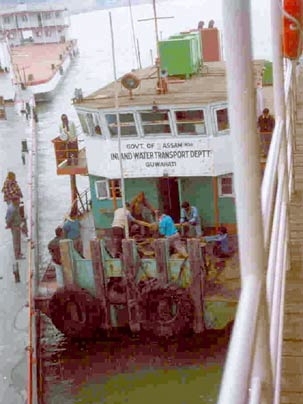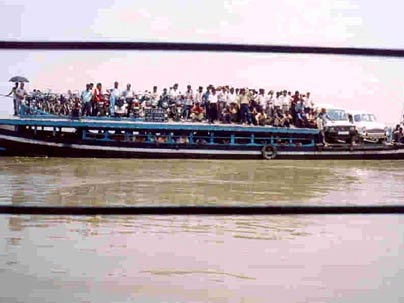Two MIT researchers have joined forces with a humanitarian effort half a world away to help bring relief to a region of India routinely flooded by monsoonal rains each year.
The two at MIT who are associated with the student group, Association for India's Development (AID), are working with The Center for Northeast Studies (CNES) in New Delhi and grassroots groups in India to design and build a cargo boat for use by two villages in Assam state in Northeastern India.
Each year, monsoonal rains arrive in June causing the River Brahmaputra to flood its banks, leaving thousands of people at the foot of the Himalayas temporarily homeless while the waters come rushing down from the mountains.
The new boat will help people in villages on the river banks by bringing emergency supplies in during flooding, something that boats currently used by the Assam government can't always do because they lack the power necessary to forge the current during monsoons. People who need to be transported to dry ground will also use the boat.
First proposed by journalist Sanjoy Hazarika of CNES, the project now is taking life, thanks in part to Manu Prakash, a graduate student in the Center for Bits and Atoms, and Anand Sivaraman, a post-doctoral associate in the Biotechnology Process Engineering Center.
CNES is raising money for the boat and working with the approximately 150 families to develop small-animal husbandry (mainly Croiler chickens, which have high egg-yielding hens) and other small-scale industries like weaving so that during drier times, the new boat will allow the villagers to develop alternative means of trade. They'll be able to use it to transport agricultural crops, such as eggs, and woven goods to markets downriver. Eventually the boat also might be used as a floating schoolhouse. "The boat will satisfy both purposes--the need for a more formal school for children of the communities and for a boat that can help act as a relief vessel during flood emergencies," said Sivaraman.
The first boat, expected to cost about $25,000 to build, is a prototype for what the group hopes will become a fleet, if they can convince the Inland Waterways Department in Assam that building many of these boats is a worthwhile endeavor.
Working with independent design engineer consultant Hari Nair in Boston, who is reviewing designs pro bono, the proposal prepared by the MIT pair and CNES became one of 10 selected from 1,500 entries to receive a $20,000 development marketplace grant from the World Bank. Using that money, Sivaraman said, local shipbuilders in India have begun building the prototype boat.
If that prototype is effective, the Inland Waterways Department in Assam has agreed to fund 50 percent of the cost of the additional vessels. The villagers, with help from CNES, will need to raise 30 percent; supporters of northeast India who live in the United States will raise the remaining 20 percent in this country.
The boat needs to be ready by May 2005 for the start of the monsoon season, but there is still much to be accomplished. Although the structural design of the 80 x 20-foot vessel is complete, the engine design is still in question. Jain believes more MIT minds would help.
"One issue with the design of boats for flood-ravaged rivers is the need to design a suitable engine and a gear box that can take the load when driving against the current," said Sivaraman. "Mechanical engineers and people working in the area of fluid dynamics and naval architecture may be able to contribute to the solution of this problem."
But it has to be an engine that can be built and repaired locally, Sivaraman points out.
"We just finished the overall rough functional requirements, and are starting the detailed design phase," said Prakash. "The objective is to retrofit commercially available heavy automobile parts to design most of the mechanical components so the least amount of customized machining is required."
Thus far, the project has been wholly unique, said Sivaraman. Bringing professional engineers who rely on their measurements and equations together with the locals who understand the needs of the community more intuitively has been humbling, he said.
"We are working with people who do not need calculations to know that something is not going to work," said Sivaraman.
A version of this article appeared in MIT Tech Talk on November 17, 2004 (download PDF).







